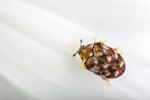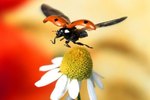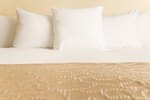
Parasitic wasps sound dangerous, however, these tiny winged insects are harmless to humans, and beneficial to gardens. The term "parasitic wasp" refers to a large grouping of parasitoids, encompassing dozens of species. Ranging from tinier than 1 millimeter to about an inch in length, these insects are termed parasitic because they lay eggs in live hosts.
Host Habitat
Female parasitic wasps colonize other insects by laying their eggs inside the live insect's body cavity, using a long stinger-like ovipositor to insert eggs under the host's skin. While caterpillars are the most common insect utilized by parasitic wasps, the wasps will also lay eggs in aphids, beetles, spiders and flies. Once the eggs hatch, the larvae consume the host from the inside out, emerging from the insect, which is possibly still living, by chewing a hole through the external skin. Once free, the parasitic wasp larvae spin cocoons, where they will grow into their next stage of life: adult wasps.
Adult Habitat
Once full grown, adult parasitic wasps can be found globally, near temperate freshwater and in backyard gardens. Some parasitic wasps feed on nectar and pollen alone, some also feed on pest insects such as aphids, locust and cabbage caterpillars. To find their prey and potential hosts for reproduction, parasitic wasps prefer cole crops, agricultural areas that support plants related to the mustard family such as cabbage, brussels sprouts, kale, collard greens, broccoli, kohlrabi, turnips and cauliflower. Because of this propensity for large, specific crops, parasitic wasps are in danger of being exterminated through pesticide use.
The Benefits of Parasitic Wasps
Gardeners and crop farmers understand that the parasitic wasp is a beneficial insect; species of parasitic wasps were introduced originally in 1883 to halt widespread ruin of cabbage crops by the cabbage white caterpillar. In 1985 a Yugoslavian strain of parasitic wasp was introduced to Michigan to assist corn farmers with the corn earworm. Parasitic wasps are not poisonous to humans, nor do they bite or pester people or their pets. Single-minded, parasitic wasps hone in and focus on garden pests, and eliminate them.
Attracting Parasitic Wasps
One option for attracting and keeping parasitic wasps is to contact a beneficial insect distributor. In this case, you would purchase a selection of live parasitic wasps and release them into your garden, following the directions the distributor included. Alternatively, you could plant vegetables and flowers that parasitic wasps are known to prefer, such as flowers in the daisy, mint or carrot families. To determine if parasitic wasps are in your garden, look for golden cocoons around caterpillar bodies, or dried, enlarged brown aphid corpses littering the stalks of plants.
References
Resources
Photo Credits
-
Hemera Technologies/Photos.com/Getty Images




